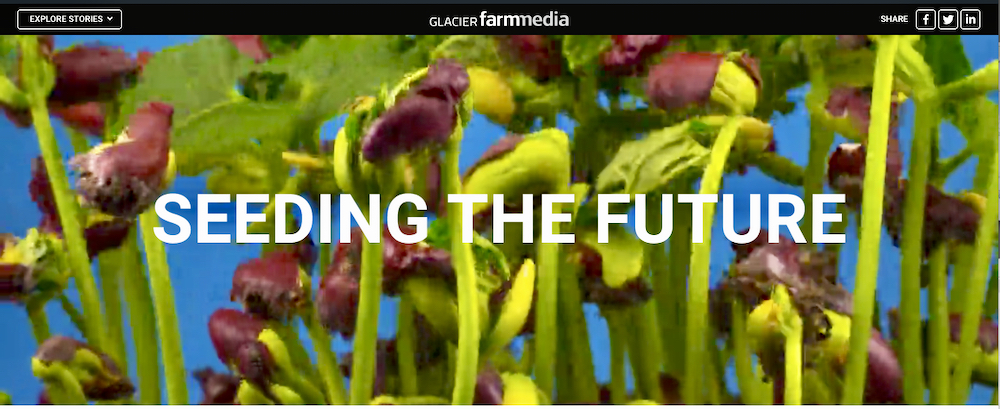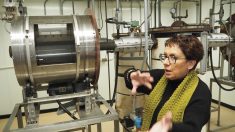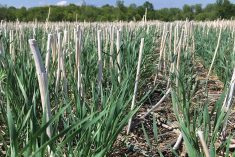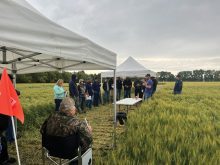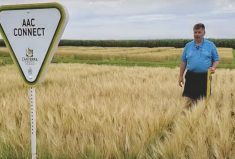Barley breeders have got their first look under the proverbial hood when it comes to genomic selection, and researchers say it bodes well for future varieties coming down the pipe.
Why it matters: The first reference genome in Canadian malt barley sets the stage for a more streamlined, less expensive breeding process.
Ana Badea, a researcher at Brandon’s Agriculture and Agri-Food Canada (AAFC) station has now helped successfully sequence the first Canadian malt barley variety, work that only took a year.
Read Also

Riding market swings can add farm profit
Regular price trends in the grain market can help farmers pinpoint how and when to sell their grain with more confidence, analyst says
Her goal was a completed reference genome for AAC Synergy, the (albeit distant) third most popular barley variety to go into the ground last year, according to Manitoba Agricultural Services Corporation data.
The benefit to the barley sector will be multi-pronged, according to Badea. The development of molecular markers and help in targeting traits earlier and better will speed variety development — a timeline typically estimated at a decade — while also cutting the cost of developing that variety.
“The work that we are doing will help us be more efficient and make the breeding process smoother,” Badea said. “We will be able to more accurately conduct our breeding selection. This in turn will result in improved varieties that will get into the farmer’s hands as well as, if we talk about malting barley, malt houses, brewers and so on.”
Badea suggested that the work might help streamline breeding in several ways. Firstly, she suggested the project might help improve the source of germplasm for parent lines, work that she says is generally not considered in the 10-year timeline most breeders cite.
Secondly, a working knowledge of a variety’s genome will help winnow traits during the early generations of the breeding process. Researchers generally have a lot of lines, but with few making the cut during early selections, she noted, while trait-specific analysis during breeding can be costly.
“Having something like molecular markers for example, perfect molecular markers, because we potentially will find out which are the genes involved, will help us to apply the selection earlier, and thus we could glean a higher number of materials and be able to find that golden variety,” she said.
Peter Watts, managing director of the Canadian Malting Barley Technical Centre, is excited about the implications.
“If we can get a better understanding of the genome of barley and understand how different quality attributes are generated, then clearly from a breeding standpoint, if we can breed in better quality characteristics that relate to things like malting or brewing performance or sensory performance in the end product — in other words, beer — that’s obviously super powerful,” he said.

Adoption lag?
At the same time, the malt barley sector has not been known for quick adoption of new varieties and, in fact, has been noted for a significant drag in new genetics hitting the field.
In a 2017 report presented to SaskBarley, authors noted that new malt barley varieties were hitting the market, but about 80 per cent of the barley grown in Canada at the time was still put to two varieties, both several decades old. Most new varieties, in comparison, never top five to 10 per cent of market share.
Asked whether varieties coming out of this project might face similar hurdles, Watts argued that it’s a challenge he feels the industry can meet.
“That’s a challenge for us as an industry, to make sure that we’re communicating with the buyers and the end-users about new varieties and their quality characteristics and give them the opportunity to test drive them… and then it’s up to them,” he said.
“Certainly, once you’re familiar with something, you’d rather not change, but if a buyer has the opportunity to test something out and it performs as well or better than an existing variety, why wouldn’t they try that?” he added.
Part of the whole
The project is part of the larger Targeted and Useful Genomics for Barley and Oat project, or TUGBOAT, a five-year, multi-stakeholder barley and oat initiative out of AAFC that started in 2019. The project is drawn from a longer-running genomics initiative out of AAFC, project lead Nick Tinker said.
“We’ve had a strong presence in oat genomics for a long time,” he said. “Barley is a little bit newer in Agriculture Canada, so this project kind of grew out of an interest to leverage the work that we did on oat into barley as well.”
Within the project, oats have more basic genomics work complete, he noted, but added that globally speaking, the pool of knowledge for barley is more robust.
“We’re kind of leveraging both each way,” he said. “We’re leveraging our experience of oat in Ag Canada, but we’re leveraging the fact that barley is a simpler, smaller genome to work on and trying to learn from barley.”

Within TUGBOAT, oat development currently has access both to their own completed oat genomes from Canadian varieties (knowledge Tinker says was new last year) and public oat genome sequencing.
“We’re now at the stage where we hope to put names on some of the genes that we’ve discovered through classical genetics, and barley will help us do that,” he said. “We even think that, down the road, experimentally we may be able to do some work in transformation with our partners at McGill University in barley and oat to test a gene and see how it works.”
As well as building the science, the oats team has been applying its genomic selection in the field for the last five years, work that is just getting its foundations now in barley.
Selection starts with a training population of about 400 lines, Tinker said. From there, lines undergo genetic marker analysis and careful measurement of traits. Those lines are then exposed to multiple environments, data that then feeds back into a statistical model to inform selection in a new population, which can be developed in the greenhouse.
“You would never release a variety that you’ve predicted statistically without actually testing it. You’d probably be setting yourself up for disaster that way. But you can screen traits that would be very difficult to select very early in the breeding program,” he said.
That regional environment training has also created interest between eastern and western Canadian breeders, he said, and there had been a trade of predictive data to forecast how a variety might do in another part of the country.
In the oat program, the process has been particularly helpful in selecting for yield before other traits.
“Which is kind of backwards from what we used to do in conventional breeding,” Tinker said. “You can’t measure yield until you take a line out and grow it in a lot of environments and the multiple environments are the key, whereas we’ve got our training population trained for yield and trained in the environments where we want our varieties to perform well.”
The first oat variety spanning off from the project was put up for registration last year, but fell short on test weight.
Where the work goes now
While excited about the project’s current laurels, Badea says it’s only the beginning.
“While we have a reference genome, we need now to learn more about the genes — what’s making AAC Synergy unique? What is the difference? Why is Synergy different from other cultivars of barley? So that is our next step and the following step will be to get that new data and new information to implement them into the breeding program,” she said.
At the same time, she said, she expects to create similar reference genomes for other Canadian cultivars. Morrison, an older variety out of Eastern Canada, and AAC Connect, a variety pegged for its resistance to diseases like fusarium head blight, are both on that to-do list, along with feed variety CDC Austenson, Manitoba’s most popular barley choice last year.
Seeding the Future
Want to find out more about what’s happening in the field of plant genetics and breeding programs? Click the image below to visit ‘Seeding the Future‘ at gfmdigital.com for a range of multimedia projects created by the team at Glacier FarmMedia.



